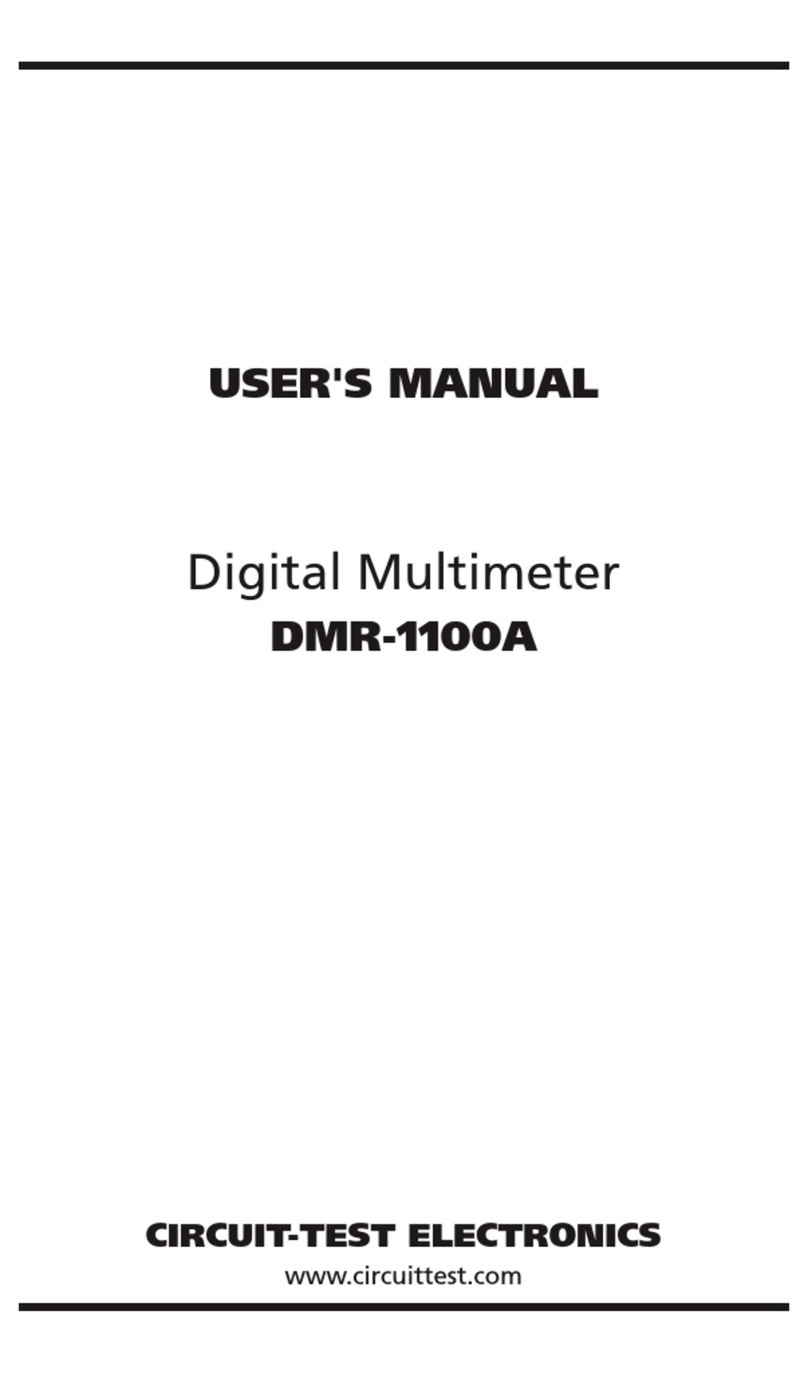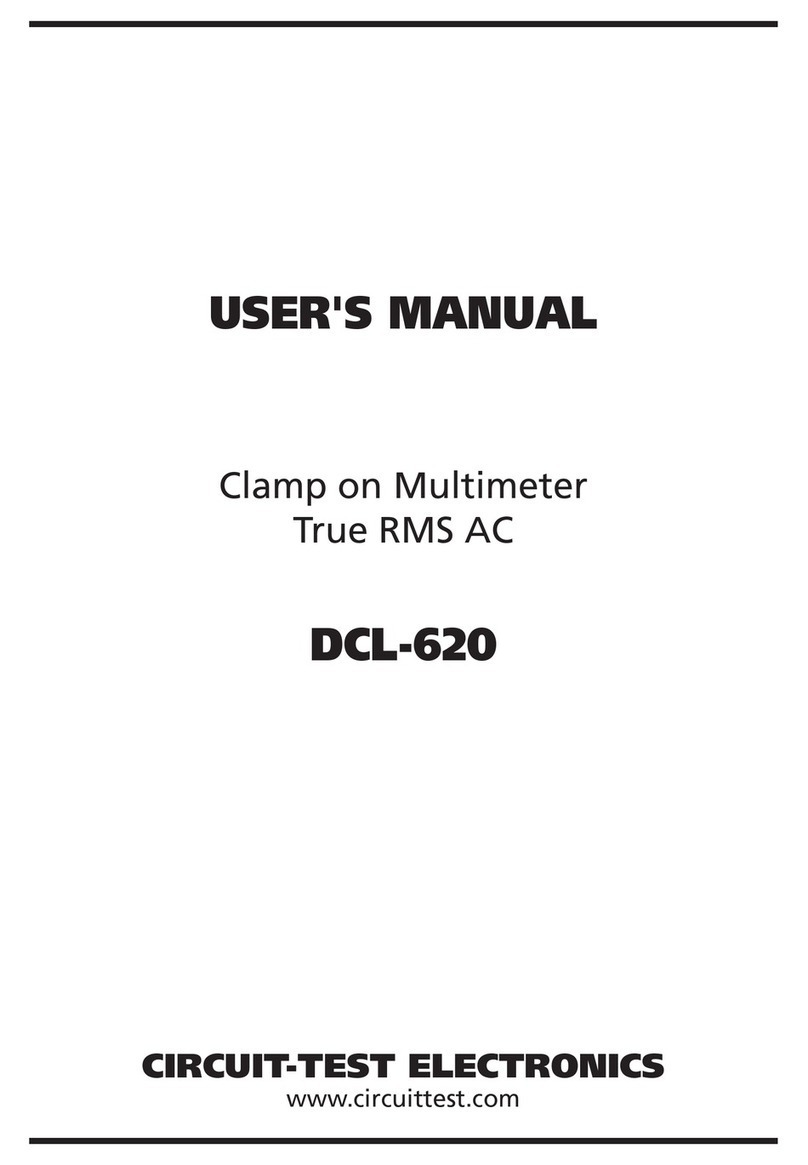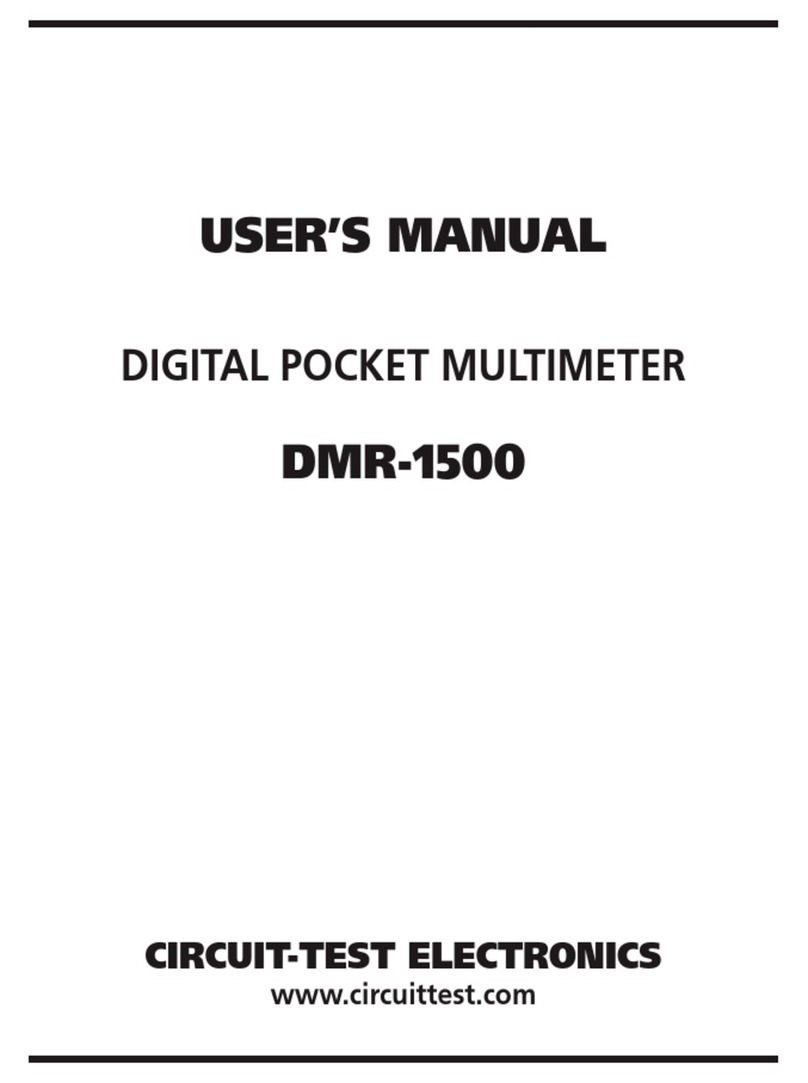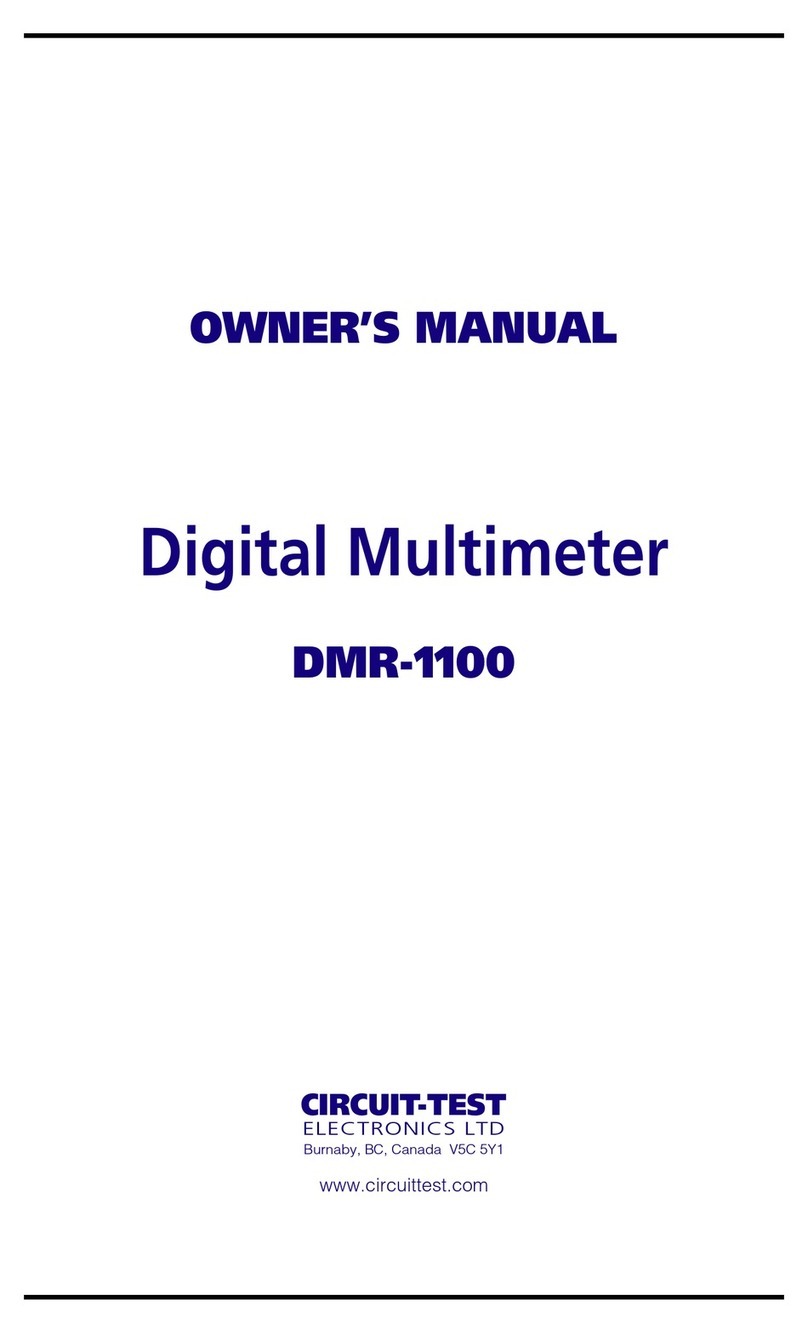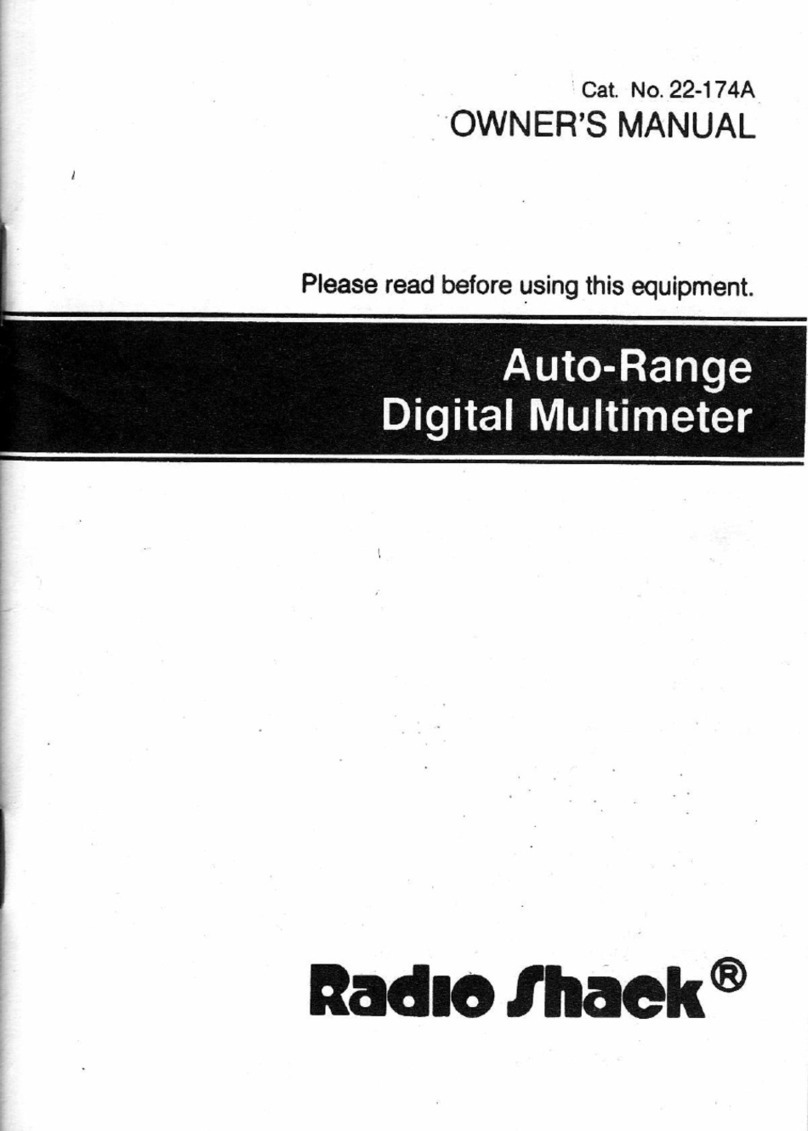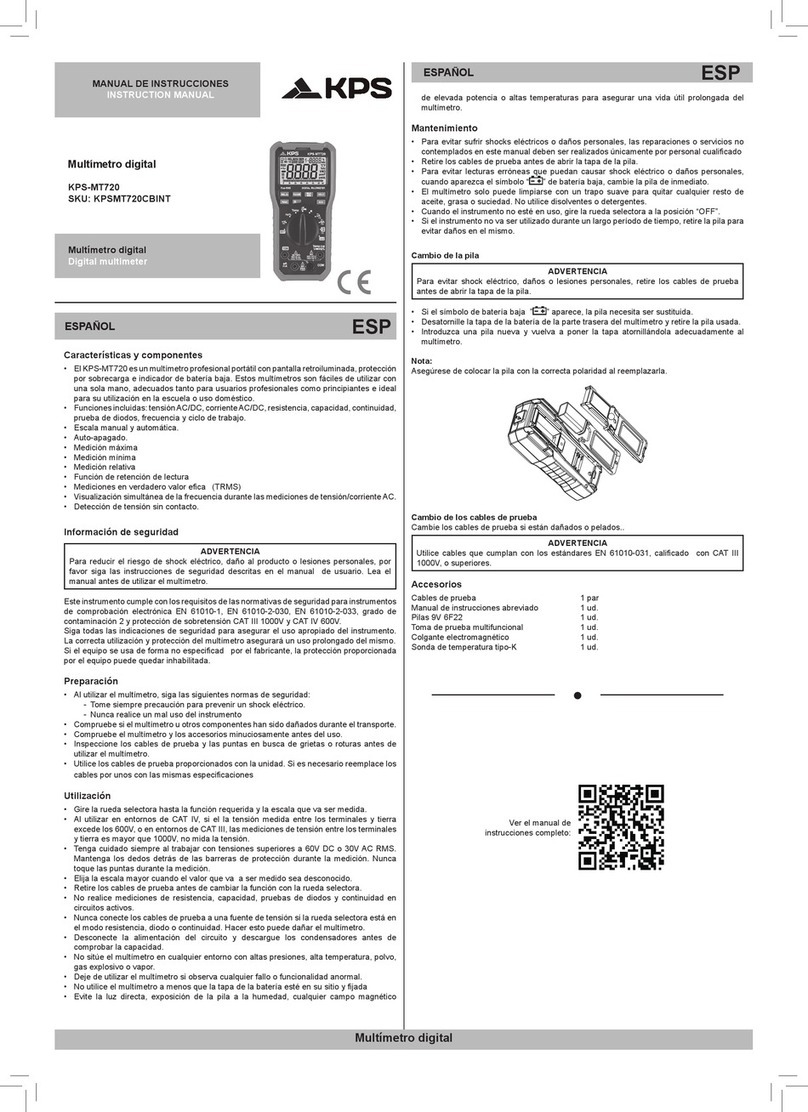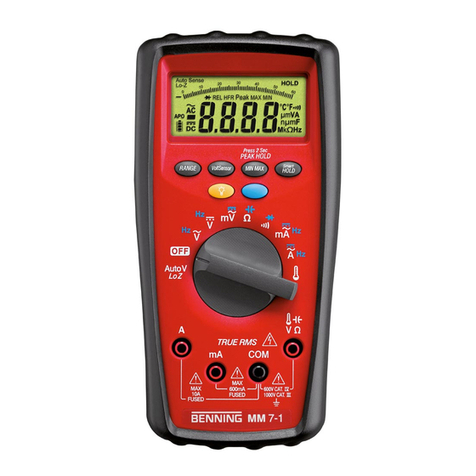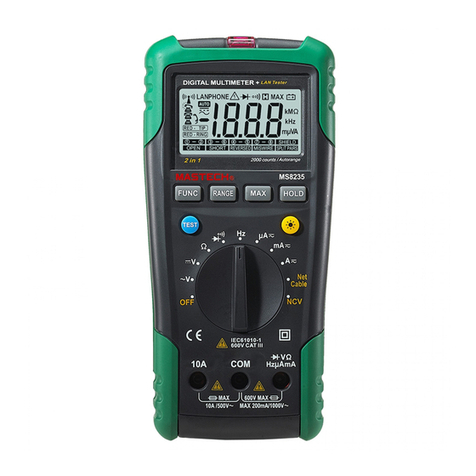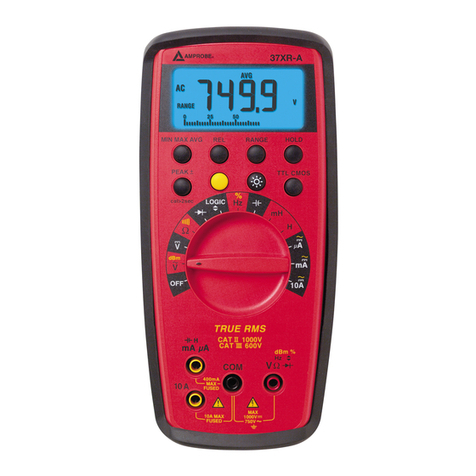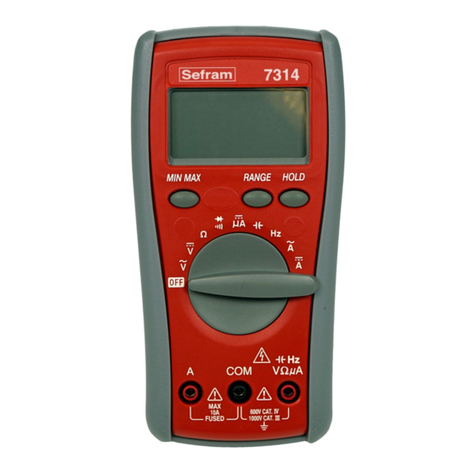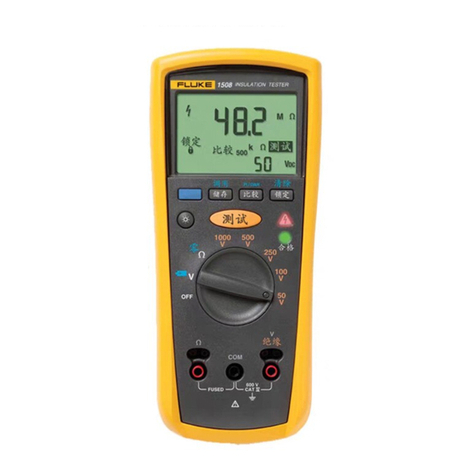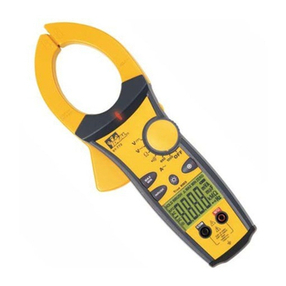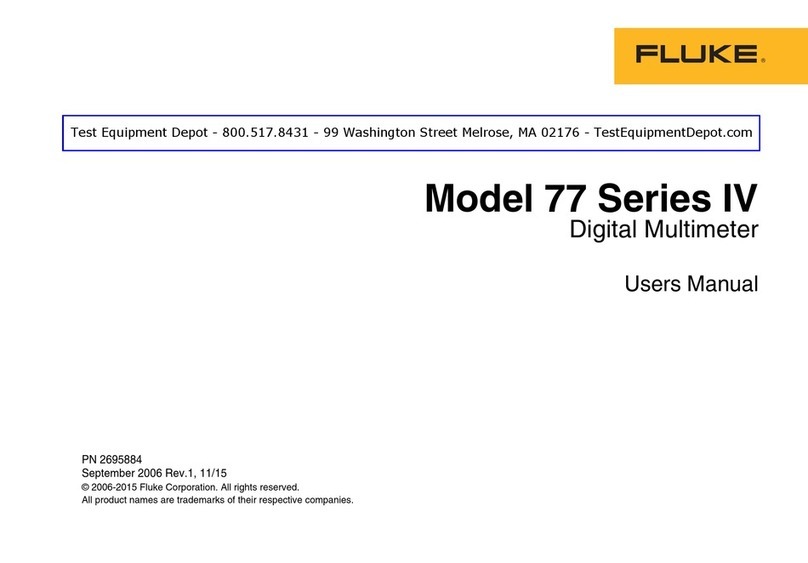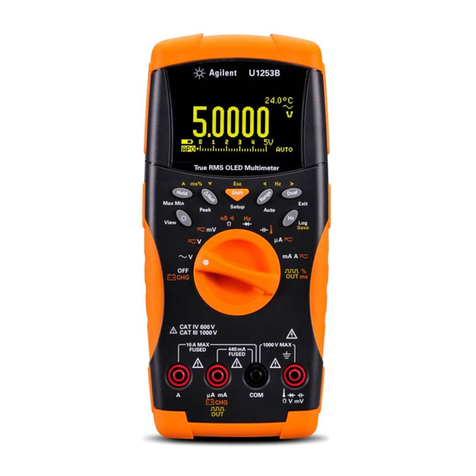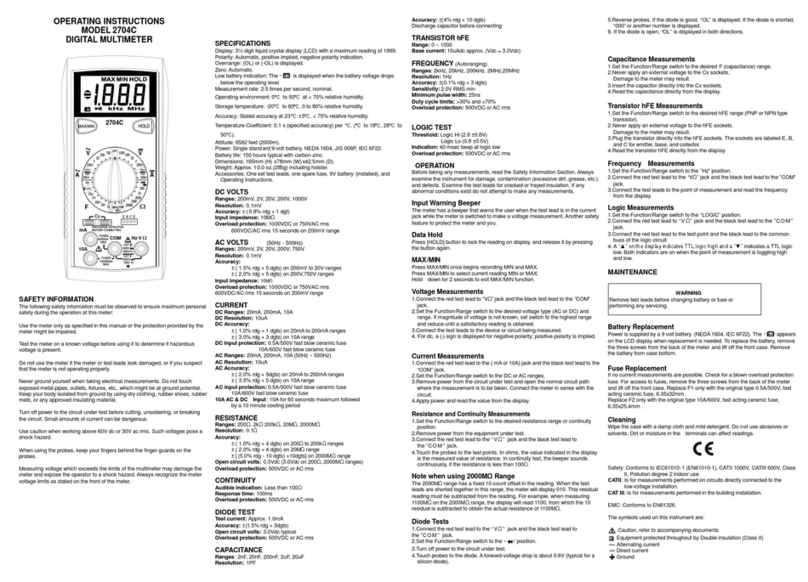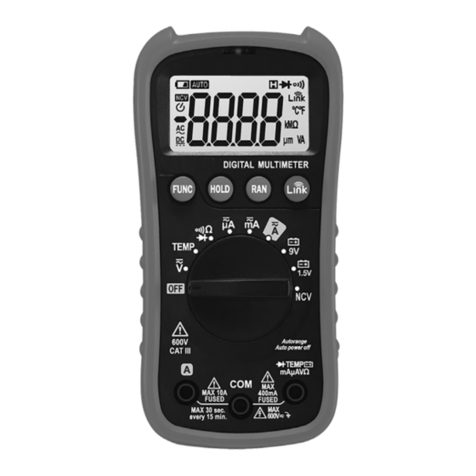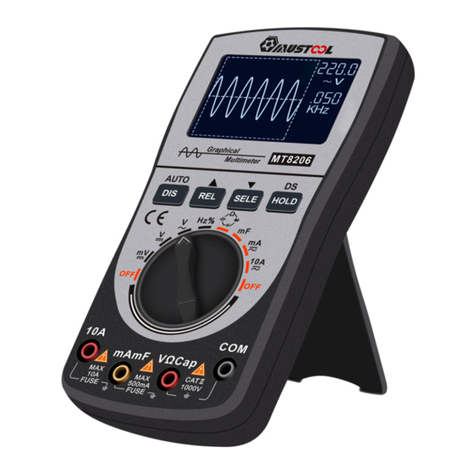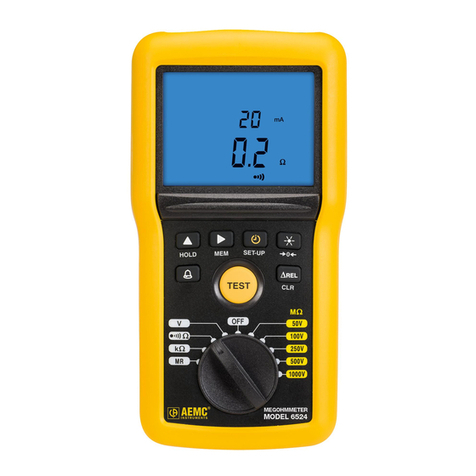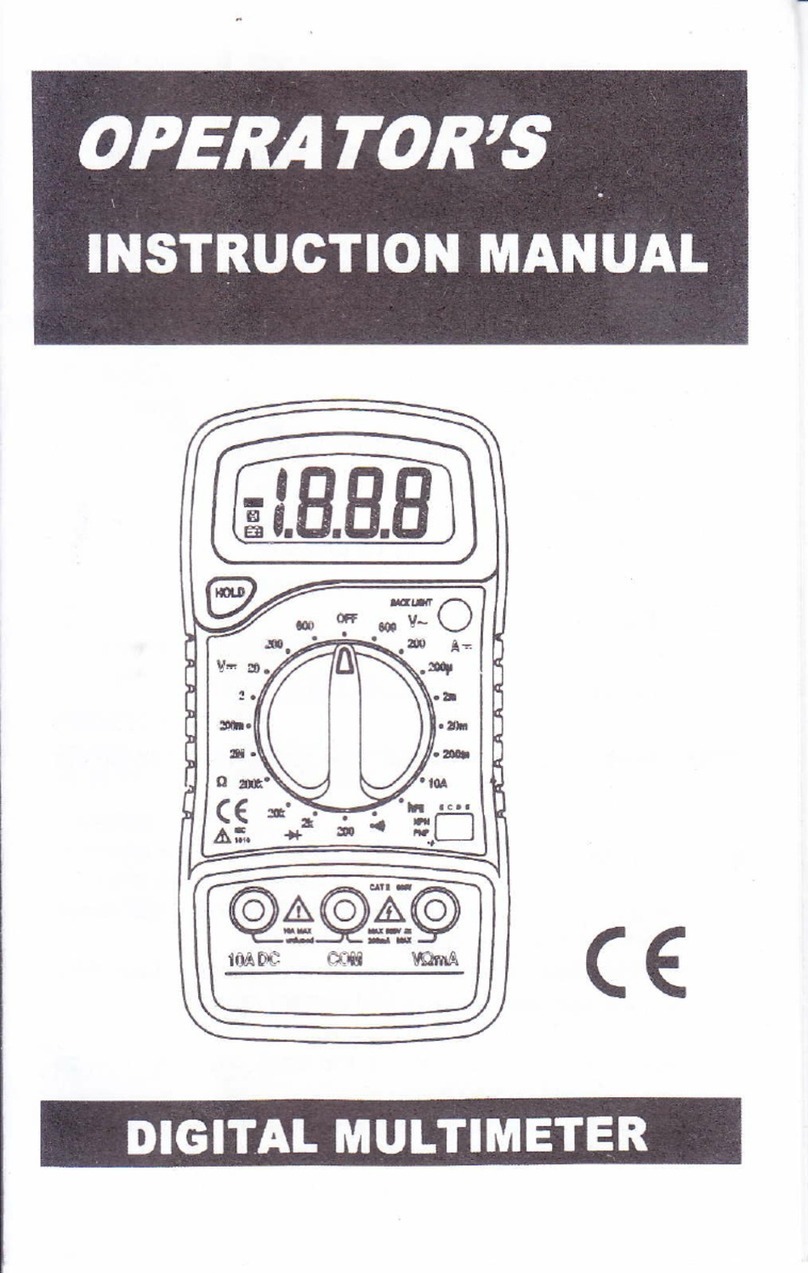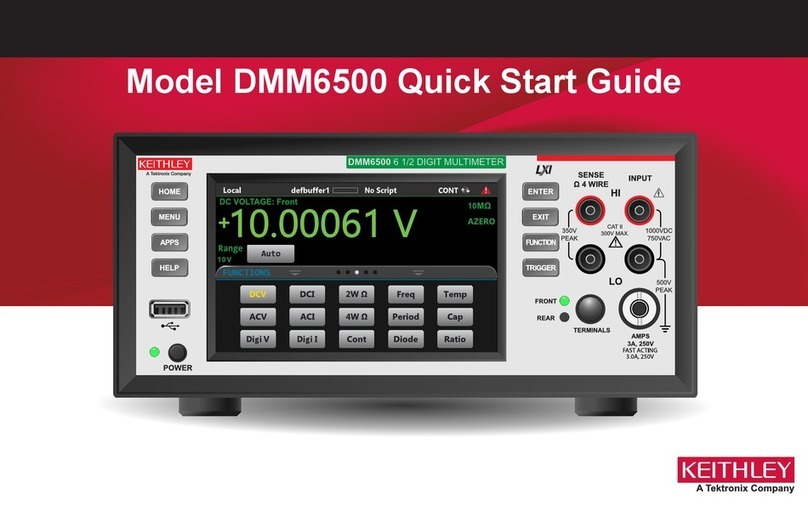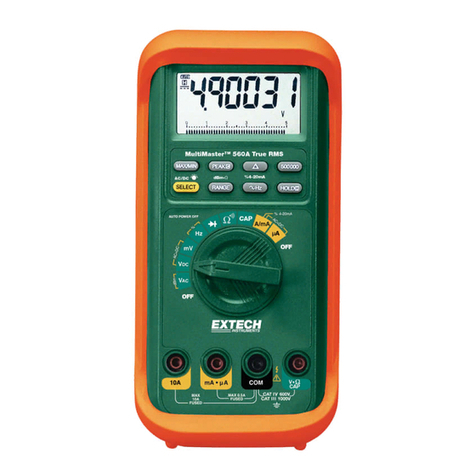Circuit-test DMR-6550 User manual

USER'S MANUAL
Multimeter
True RMS Auto ranging
DMR-6550
CIRCUIT-TEST ELECTRONICS
www.circuittest.com

- 2 -
Introduction
Safety
This meter measures AC/DC Voltage, AC/DC Current, Resistance,
Capacitance, Frequency, Diode Test, Continuity plus Thermocouple
Temperature. Proper use and care of this meter will provide many years of
reliable service.
This symbol adjacent to another symbol, terminal or operating
device indicates that the operator must refer to an explana-
tion in the Operating Instructions to avoid personal injury or
damage to the meter.
This WARNING symbol indicates a potentially hazardous
situation, which if not avoided, could result in death or serious
injury.
This CAUTION symbol indicates a potentially hazardous situ-
ation, which if not avoided, may result damage to the product.
This symbol advises the user that the terminal(s) so marked
must not be connected to a circuit point at which the voltage
with respect to earth ground exceeds (in this case) 500 VAC
or VDC.
This symbol adjacent to one or more terminals identies them
as being associated with ranges that may, be subjected to
particularly hazardous voltages. For maximum safety, the meter
and test leads should not be handled when these terminals
are energized.
Double Insulation.

- 3 -
SAFETY INFORMATION
Caution and proper guidelines must be followed for personal and product safety.
Read this instruction manual carefully and completely before using the meter.
Lack of caution or poor safety practices can result in serious injury or death.
• Always start with power off. Set the function switch to the correct setting
before making any measurements and do not change position of the func-
tion switch during measurements.
• Do not use the meter if the meter or test leads look damaged or if there is
doubt that the meter is not operating properly.
• When using the test probes always keep ngers behind the nger guards.
Never touch the exposed probe tip.
• Always consider circuits to be energized. Never assume any equipment
to be de-energized.
• Use caution when working above 35VDC or 25VAC RMS as these volt-
ages pose a shock hazard.
• Never connect unit to AC or DC powered circuits when the function switch
is set to resistance, diode check or continuity ranges.
• Always disconnect the power when performing resistance, or diode tests.
• Always turn off the power to the circuit under test before unsoldering or
breaking the circuits. Small amount of current can be dangerous.
• Disconnect test leads before removing the batteries or the fuse.
• Do not operate the unit unless the case is completely closed.

- 4 -
SAFETY INSTRUCTIONS
This meter has been designed for safe use, but must be operated with caution.
The rules listed below must be carefully followed for safe operation.
1. NEVER apply voltage or current to the meter that exceeds the specied
maximum:
Input Limits
Function Maximum Input
V DC or V AC 1000VDC/VAC
A DC/AC 10A DC/AC (30 seconds max every
15 minutes)
Frequency, Resistance,
Capacitance, Duty Cycle, Diode
test, Continuity
600V DC/AC rms
Temperature 600V DC/AC rms
2. USE EXTREME CAUTION when working with high voltages.
3. NEVER connect the meter leads across a voltage source while the
function switch is in the current, resistance, or diode mode. Doing so
can damage the meter.
4. ALWAYS discharge lter capacitors in power supplies and disconnect
the power when making resistance or diode tests.
5. ALWAYS turn off the power and disconnect the test leads before open-
ing the covers to replace the fuse or batteries.
6. NEVER operate the meter unless the back cover and the battery and
fuse covers are in place and fastened securely.

- 5 -
Controls and Jacks
1. 6000 count LCD Display
2. Function switch
3. 10A (positive) input jack
4. COM (negative) input jack
5. Positive input jack
6. HOLD & Backlight button
7. Max/Min button
8. Range/ /Diode button
9. Hz/% button
Continuity
Low Battery
Diode
HOLD Data Hold
AUTO AutoRanging
AC Alternating Current or Voltage
DC Direct Current or Voltage
Symbols and Annunciators

- 6 -
Specications
Display: 6000 counts LCD display.
Polarity: Automatic, (-) negative polarity indication.
Input Impedance: 7.8MΩ
Overrange: “OL” mark indication.
AC Response: True RMS
Low battery indication: “ ” is displayed if the battery voltage drops below
operating voltage.
Measurement rate: 2 times per second, nominal.
Auto power off: Automatically shuts down after approx. 15 minutes
of inactivity.
Operating Temperature: 0ºC to 50ºC (32ºF to 122ºF) at < 70 % relative
humidity.
Storage temperature: -20ºC to 60ºC (-4ºF to 140ºF) at < 80 % relative
humidity.
Fuse: 10A/250V Fuse, Fast blow 5x20mm
Battery: One 9V, NEDA 1604 battery.
Dimensions: 150 (H) x 70 (W) x 48 (D) mm
Weight: Approx.: 255g
Enclosure: Double molded
Safety / Approvals: This meter is UL and CUL approved and con-
forms to IEC61010-1 for Overvoltage Category
CAT III 600V and CAT II 1000V.

- 7 -
DC Voltage
Range Resolution Accuracy
600.0mV 0.1mV ±0.5% of reading ± 2 digits
6.000V 1mV
±1.2% of reading ± 2 digits60.00V 10mV
600.0V 100mV
1000V 1V ±1.5% of reading ± 2 digits
AC Voltage
Range Resolution Accuracy
6.000V 1mV ±1.5% of reading ± 10 digits
60.00V 10mV ±1.5% of reading ± 10 digits
600.0V 100mV
1000V 1V ±2.0% of reading ± 10 digits
DC Current
Range Resolution Accuracy
6A 1mA ±2.5% of reading ± 5 digits
10A 10mA
Overload Protection: 10A / 250V Fuse.
Note: Accuracy is given at 18ºC to 28ºC (65ºF to 83ºF), < 70 % RH
AC Current
Range Resolution Accuracy
6A 1mA ±3.0% of reading ± 5 digits
10A 10mA

- 8 -
Resistance
Range Resolution Accuracy
600.0Ω 0.1Ω ±1.2% of reading ± 4 digits
6.000kΩ 1Ω ±1.0% of reading ± 2 digits
60.00kΩ 10Ω ±1.2% of reading ± 2 digits
600.0kΩ 100Ω
6.000MΩ 1kΩ ±2.0% of reading ± 2 digits
60.00MΩ 10kΩ ±5.0% of reading ± 10 digits
Capacitance (Auto-ranging)
Range Resolution Accuracy
40.00nF 10pF ±5.0% of reading ± 50 digits
400.0nF 0.1nF ±3.0% of reading ± 5 digits
±3.0% of reading ± 5 digits
4.000uF 1nF
40.00uF 10nF
400.0uF 0.1uF ±5.0% of reading ± 5 digits
4000uF 1uF ±5.0% of reading ± 5 digits
Frequency (Auto-ranging)
Range Resolution Accuracy
9.999Hz 0.001Hz ±1.5% of reading ± 5 digits
99.99Hz 0.01Hz
999.9Hz 0.1Hz
±1.2% of reading ± 3 digits
9.999kHz 1Hz
99.99kHz 10Hz
999.9kHz 100Hz
10MHz 1kHz ±1.5% of reading ± 4 digits
Sensitivity: >0.5V RMS while ≤1MHz;
Sensitivity: >3V RMS while >1MHz

- 9 -
Duty Cycle
Range Resolution Accuracy
0.1%~99.9% 0.1% ±1.2% of reading ± 2 digits
Pulse width: >100us, <100ms;
Frequency width: 5Hz – 150 kHz
Sensitivity: >0.5V RMS
Temperature
Range Resolution Accuracy
-20ºC~+760ºC 1ºC ±3% of reading ±5ºC/9ºF
-4ºF~+1400 ºF 1ºF
Sensor: Type K Thermocouple
Diode Test
Range Resolution Accuracy
0.3mA typical 1 mV ±10% of reading ± 5 digits
Open circuit voltage: 1.5V dc typical
Audible continuity
Audible threshold: Less than 100Ω Test current: <0.3mA

- 10 -
Operating Instructions
Autoranging/Manual Range Selection
1. Press the RANGE key. The “AUTO” display indicator will turn off.
2. Press the RANGE key to step through the available ranges until you
select the range you want.
3. To exit Manual Ranging, press and hold RANGE key for 2 seconds.
WARNING: Risk of electrocution. High-voltage circuits, both AC and DC,
are very dangerous and should be measured with great care.
1. ALWAYS turn the function switch to the OFF position when the meter
is not in use. This meter automatically shuts OFF after 15 minutes of
inactivity.
2. If “OL” appears in the display during a measurement, the value exceeds
the range you have selected. Change to a higher range.
NOTE: On some low AC and DC voltage ranges, with the test leads not con-
nected to a device, the display may show a random, changing reading. This
is normal and is caused by the high-input sensitivity. The reading will stabilize
and give a proper measurement when connected to a circuit.
When the meter is rst turned on, it automatically goes into Autoranging. This
automatically selects the best range for the measurements being made and is
generally the best mode for most measurements. For measurement situations
requiring that a range be manually selected, perform the following:
NOTE: Manual ranging does not apply for Capacitance, Frequency functions.

- 11 -
MAX/MIN
NOTE: When using the MAX/MIN function in Autoranging mode, the meter will
“lock” into the range that is displayed on the LCD when MAX/MIN is activated.
If a MAX/MIN reading exceeds that range, an “OL” will be displayed. Select
the desired range BEFORE entering MAX/MIN mode.
1. Press the MAX/MIN key to activate the MAX/MIN recording mode. The
display icon "MAX" will appear. The meter will display and hold the
maximum reading and will update only when a new “max” occurs.
2. Press the MAX/MIN key again and the display icon "MIN" will appear.
The meter will display and hold the minimum reading and will update
only when a new “min” occurs.
3. To exit MAX/MIN mode press and hold the MAX/MIN key for 2 seconds
Display Backlight
Press and hold the HOLD key for >1 second to turn on or off the display
backlight function. The backlight will automatically turn off after 10 seconds.
HOLD
The hold function freezes the reading in the display. Press the HOLD key
momentarily to activate or to exit the HOLD function.

- 12 -
DC Voltage Measurements
CAUTION: Do not measure DC voltages if a motor on the circuit is being
switched ON or OFF. Large voltage surges may occur that can damage
the meter.
1. Set the function switch to the position.
2. Insert the black test lead banana plug into the negative COM jack and
the red test lead banana plug into the positive V jack.
3. Touch the test probe tips to the circuit under test. Be sure to observe
the correct polarity (red lead to positive, black lead to negative).
4. Read the voltage in the display.
AC Voltage Measurements
WARNING: Risk of Electrocution. The probe tips may not be long enough
to contact the live parts inside some 240V outlets for appliances because
the contacts are recessed deep in the outlets. As a result, the reading may
show 0 volts when the outlet actually has voltage on it. Make sure the probe
tips are touching the metal contacts inside the outlet before assuming that
no voltage is present.
CAUTION: Do not measure AC voltages if a motor on the circuit is being
switched ON or OFF. Large voltage surges may occur that can damage
the meter.
1. Set the function switch to the position.
2. Insert the black test lead banana plug into the negative COM jack and
the red test lead banana plug into the positive V jack.
3. Touch the test probe tips to the circuit under test.
4. Read the voltage in the display.

- 13 -
DC Current Measurements
CAUTION: Do not make current measurements on the 10A scale for longer
than 30 seconds. Exceeding 30 seconds may cause damage to the meter
and/or the test leads.
1. Insert the black test lead banana plug into the negative COM jack.
2. For DC current measurements, set the function switch to the posi-
tion and insert the red test lead banana plug into the 10A jack.
3. Remove power from the circuit under test, then open up the circuit at
the point where you wish to measure current.
4. Touch the black test probe tip to the negative side of the circuit. Touch
the red test probe tip to the positive side of the circuit.
5. Apply power to the circuit and read the current in the display.
AC Current Measurements
CAUTION: Do not make current measurements on the 10A scale for longer
than 30 seconds. Exceeding 30 seconds may cause damage to the meter
and/or the test leads.
1. Insert the black test lead banana plug into the negative COM jack.
2. For AC current measurements, set the function switch to position
and insert the red test lead banana plug into the 10A jack.
3. Remove power from the circuit under test, then open up the circuit at
the point where you wish to measure current.
4. Touch the black test probe tip to the negative side of the circuit. And
touch the red test probe tip to the positive side of the circuit.
5. Apply power to the circuit.
6. Read the current in the display. The display will indicate the proper
decimal point, value and symbol.
WARNING: To avoid electric shock, do not measure AC current on any
circuit whose voltage exceeds 250V AC.

- 14 -
Continuity Check
1. Set the function switch to the position.
2. Insert the black lead banana plug into the negative (-) jack COM and
the red test lead banana plug into the positive (+) jack Ω.
3. Press the RANGE/ / button until symbol appears in the display.
4. Touch the test probe tips to the circuit or wire you wish to check.
5. If the resistance is less than approximately 100Ω, the audible signal will
sound. The display will also show the actual resistance.
WARNING: To avoid electric shock, never measure continuity on circuits
or wires that have voltage on them.
Resistance Measurements
WARNING: To avoid electric shock, disconnect power to the unit under test
and discharge all capacitors before taking any resistance measurements.
Remove the batteries and unplug the line cords.
1. Set the function switch to the Ω position.
2. Insert the black test lead banana plug into the negative COM jack and
the red test lead banana plug into the positive Ω jack.
3. Touch the test probe tips across the circuit or part under test. It is best
to disconnect one side of the part under test so the rest of the circuit will
not interfere with the resistance reading.
4. Read the resistance in the display. The display will indicate the proper
decimal point, value and symbol.

- 15 -
Diode Test
1. Set the function switch to position.
2. Press the RANGE/ / button until the symbol appears in the
display.
3. Insert the black test lead banana plug into the negative (-) jack COM
and the red test lead banana plug into the positive (+) jack Ω.
4. Touch the test probe tips to the diode or semiconductor junction you
wish to test. Note the meter reading
5. Reverse the probe polarity by switching probe position. Note this read-
ing.
6. The diode or junction can be evaluated as follows:
A. If one reading shows a value and the other reading shows OL, the
diode is good.
B. If both readings show OL, the device is open.
C. If both readings are very small or 0, the device is shorted.
WARNING: To avoid electric shock, do not test any diode that has
voltage on it.
NOTE: The value indicated in the display during the diode check is the
forward voltage.
Frequency/Duty Cycle Measurements
1. Set the rotary function switch to the “Hz %” position.
2. Insert the black lead banana plug into the negative COM jack and the
red test lead banana plug into the positive Hz jack.
3. Touch the test probe tips to the circuit under test.
4. Read the frequency on the display.
5. Press the Hz/% button again to indicate “%” on the display.
6. Read the % of duty cycle on the display.

- 16 -
Temperature Measurements
WARNING: To avoid electric shock, disconnect both test probes from any
source of voltage before making a temperature measurement.
1. Set the function switch to ºF, or ºC position.
2. Insert the type K thermocouple probe black test lead banana plug into
the negative COM jack and the red test lead banana plug into the posi-
tive ºF / ºC jack.
3. Touch the Temperature Probe head to the part whose temperature you
wish to measure. Keep the probes touching the part under test until the
reading stabilizes (about 30 seconds).
4. Read the temperature in the display.
WARNING: To avoid electric shock, be sure the thermocouple has been
removed before changing to another measurement function
Capacitance Measurements
WARNING: To avoid electric shock, disconnect power to the unit under test
and discharge all capacitors before taking any capacitance measurements.
Remove the batteries and unplug the line cords.
1. Set the function switch to the position.
2. Insert the black test lead banana plug into the negative (-) jack COM
and the red test lead banana plug into the positive (+) jack .
3. Touch the test leads to the capacitor to be tested.

- 17 -
Replacing the Battery
1. will appear in the display when the battery drops below the operating
voltage and requires replacing.
2. Turn off the meter and disconnect the test leads from the meter.
3. Remove the two screws securing the battery cover.
4. Replace the 9V battery observing the correct polarity.
5. Replace the cover and secure the two screws.
Maintenance
WARNING: To avoid electric shock, disconnect the test leads from any
source of voltage before removing the battery door.
WARNING: To avoid electric shock, do not operate your meter until the
battery door is in place and fastened securely.
Replacing the Fuses
WARNING: To avoid electric shock, disconnect the test leads from any
source of voltage before removing the fuse cover.
1. Turn off the meter and disconnect both test leads from the meter.
2. Remove the two screws securing the battery/fuse cover and remove the
battery.
3. Remove the old fuse from its holder by gently pulling it out.
4. Replace with fuse of proper size and value (10A/250V fast blow only).
5. Replace the battery and the cover and tighten the screws.
WARNING: To avoid electric shock, do not operate your meter until the fuse
door is in place and fastened securely.

- 18 -
Limited Warranty
Circuit-Test Electronics warrants to the original purchaser that this product
be free of defect in material or workmanship for a period of 2 years from the
date of purchase.
Any product which has been subjected to misuse or accidental damage is
excluded from the warranty. Except as stated above, Circuit-Test Electronics
makes no promises or warranties either expressed or implied including war-
ranties of merchantability or the tness for any particular purpose.
M-DMR-6550 / 07R13
Table of contents
Other Circuit-test Multimeter manuals
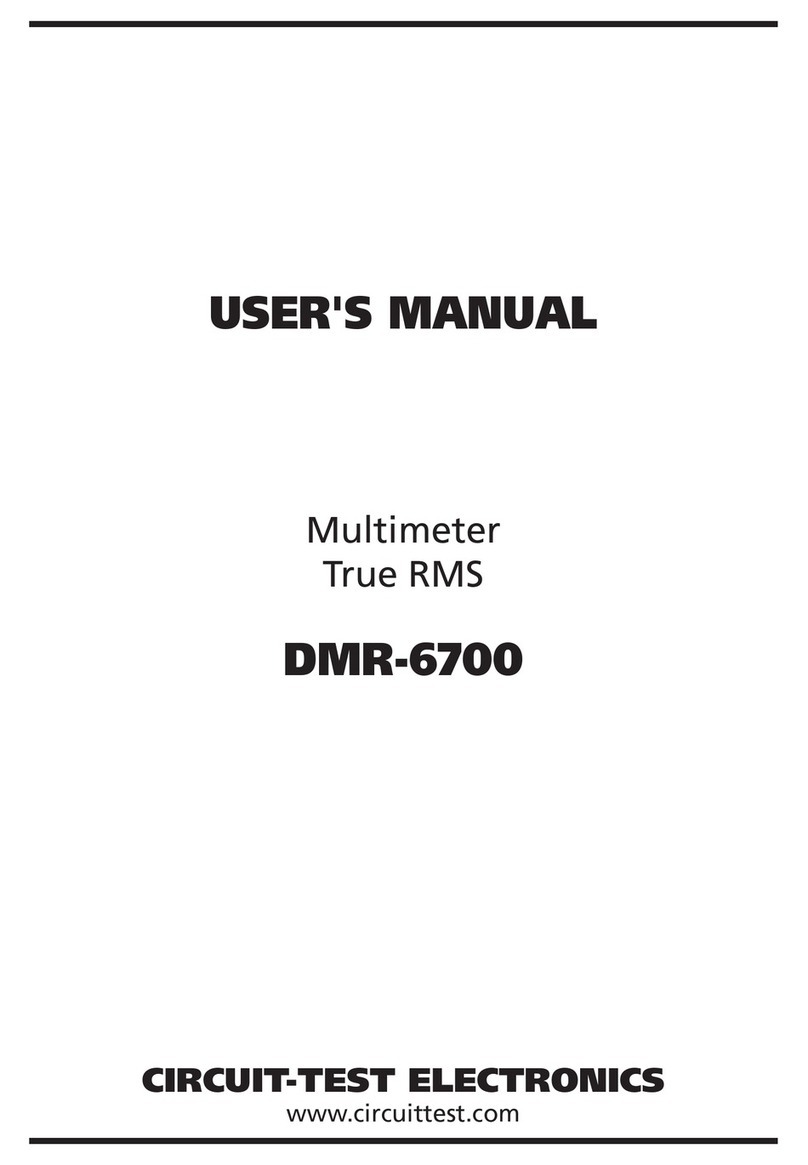
Circuit-test
Circuit-test DMR-6700 User manual
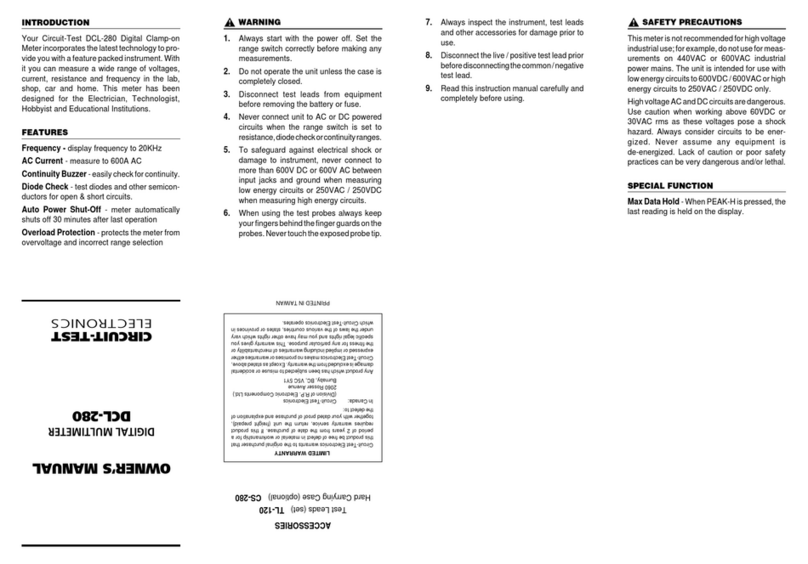
Circuit-test
Circuit-test DCL-280 User manual
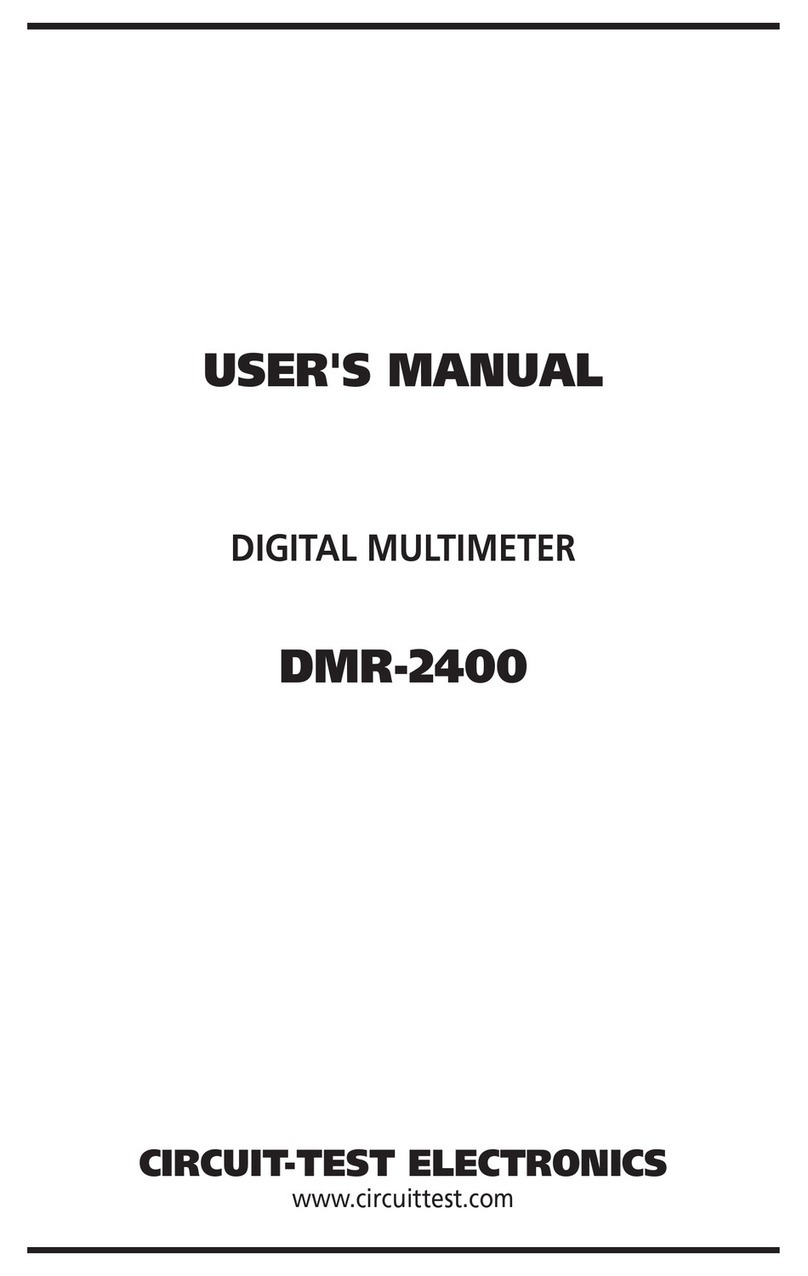
Circuit-test
Circuit-test DMR-2400 User manual
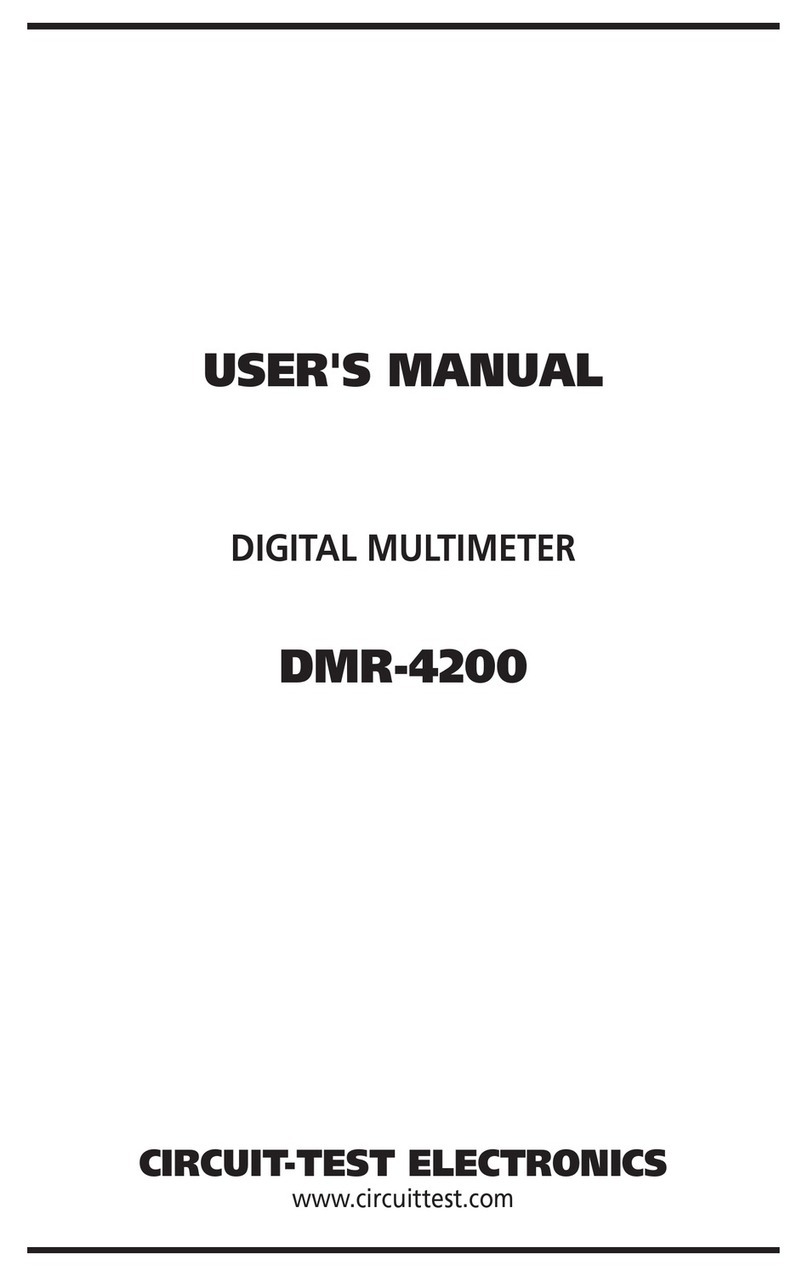
Circuit-test
Circuit-test DMR-4200 User manual
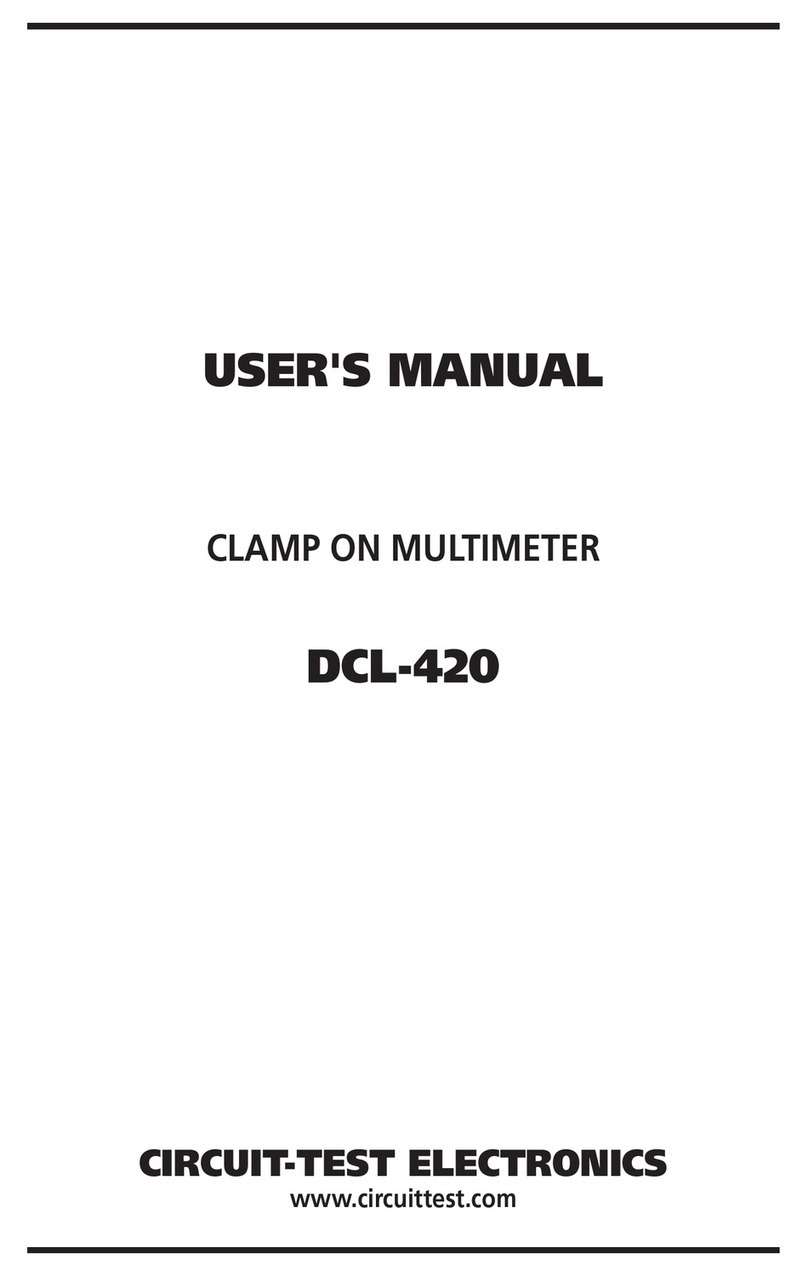
Circuit-test
Circuit-test DCL-420 User manual
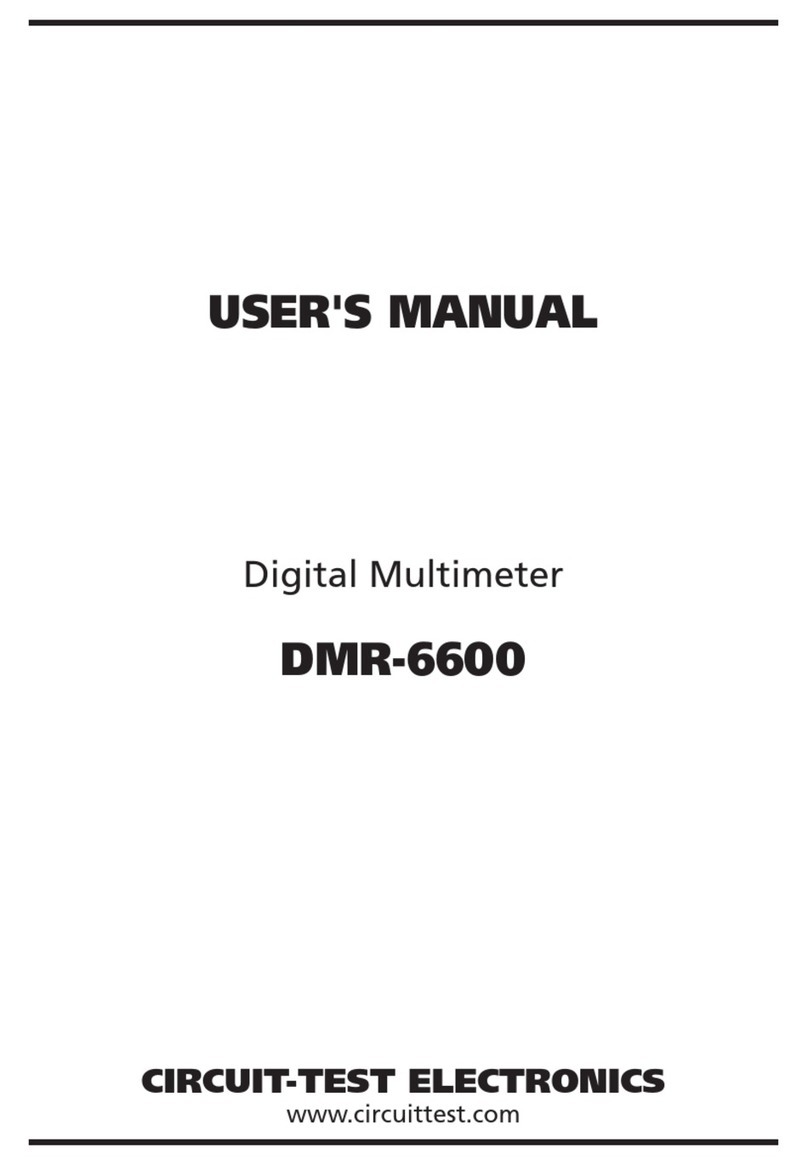
Circuit-test
Circuit-test DMR-6600 User manual
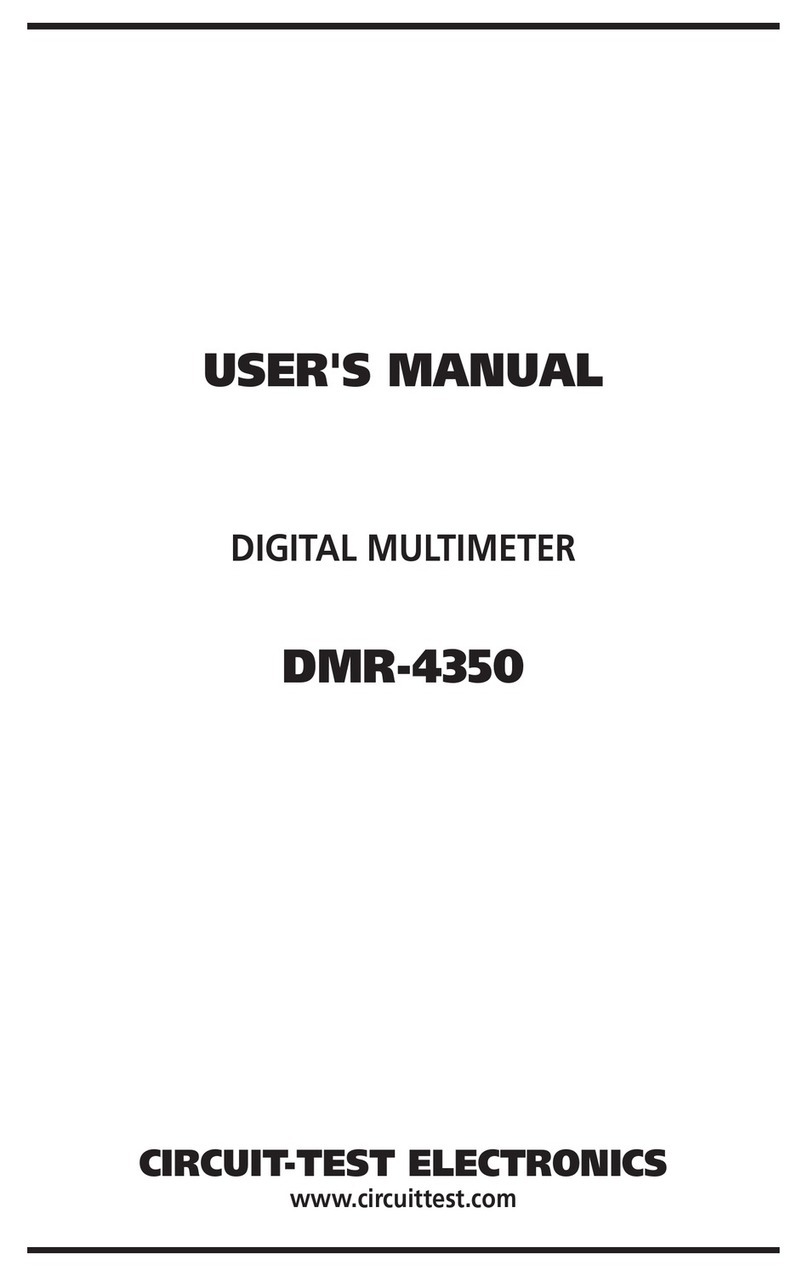
Circuit-test
Circuit-test DMR-4350 User manual
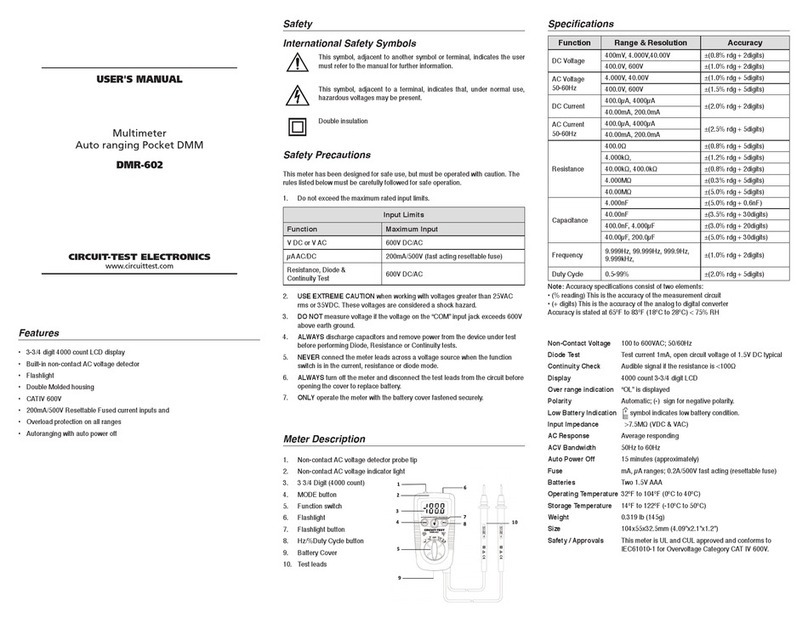
Circuit-test
Circuit-test DMR-602 User manual
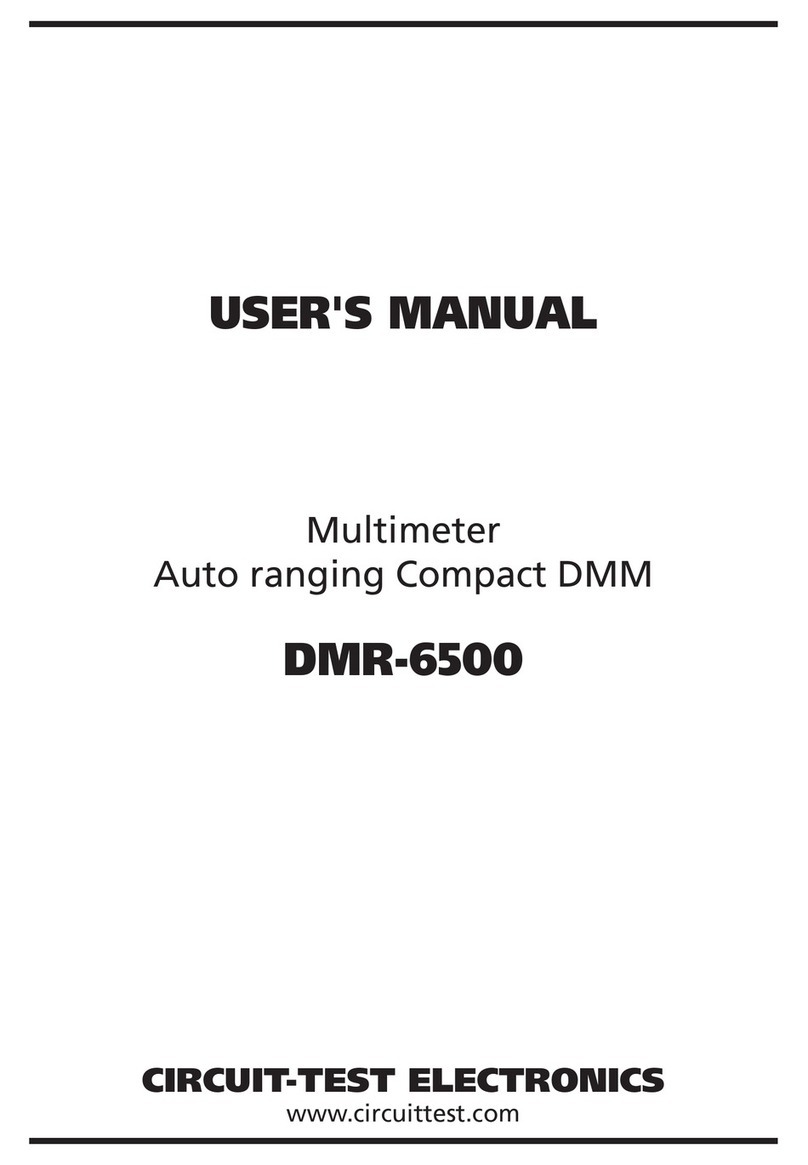
Circuit-test
Circuit-test DMR-6500 User manual
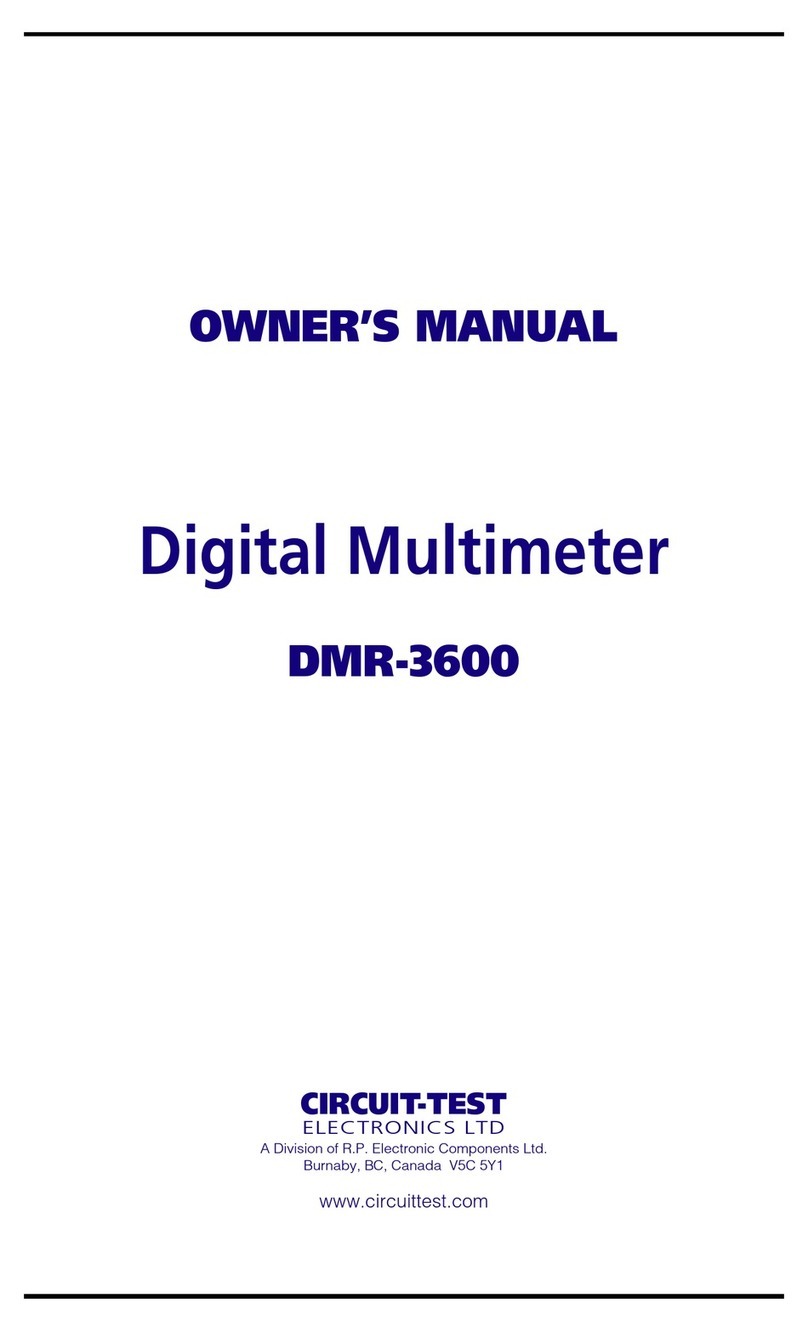
Circuit-test
Circuit-test DMR-3600 User manual
